Navigation: Fault Management > Troubleshooting Guide > Login and Registration Faults > IP Phone >
Let's come to the possible causes and troubleshooting methods for the IP phone login failure.
Possible Causes
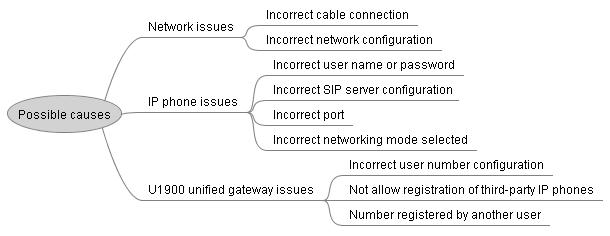
Troubleshooting Methods
1.Check the network connectivity by running the ping command.
2.Check whether the user account, password, and the IP address and port number of the registrar SIP server are correctly configured on the IP phone.
3.Check whether the user number is configured on the X1900 unified gateway. If it is configured, check its status.
4.Check whether a functional IP phone can be successfully registered using the same number.
5.Check whether the X1900 unified gateway allows registration of third-party IP phones.
6.Capture messages of the X1900 unified gateway.
Troubleshooting Common Faults
Fault 1: connection issues
Verify that the network cable is connected to the LAN port, not the PC port, of the IP phone.
Figure 1 Cable connections of the IP phone
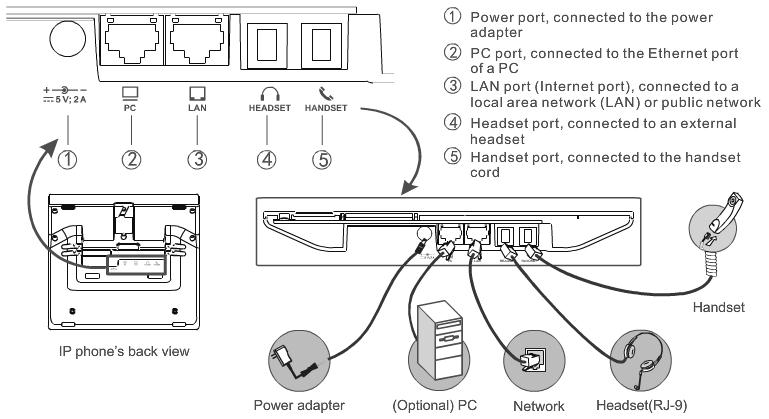
Fault 2: network configuration error
1.The registration fails after the static IP address is configured on the IP phone.
If the IP phone uses the static IP address, verify that the IP address, subnet mask, and gateway address are correct.
On the Apps > Status > Network > IPv4 Network Status screen, configure the IP address, subnet mask, and gateway address.
2.If multiple IP phones cannot obtain IP addresses, verify that the DHCP server functions properly.
Possible Cause |
Solution |
The IP phone is disconnected from the SIP server. (The VLAN or 802.1x parameters are incorrectly set.) |
On the phone login screen, choose Advanced > Network > Access, and set correct VLAN or 802.1x parameters. |
If the IP phone is properly connected to the SIP server, the DNS server address is not configured on the IP phone when the SIP server address is in domain name format. |
Enter the correct DNS server address. |
Fault 3: incorrect user password
A password error message is displayed during IP phone login, or the registration fails.
Verify that the user password is correctly configured on the IP phone.
In the web management system of the unified gateway, choose User > SIP User. On the page that is displayed, click ![]() next to the password and change the password.
next to the password and change the password.
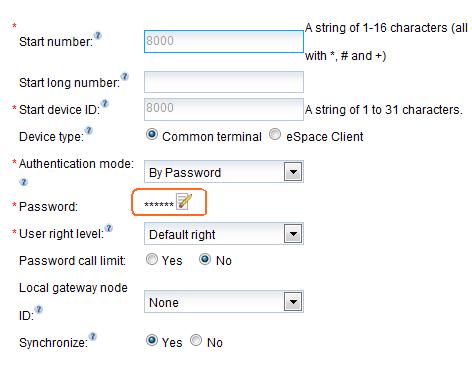
Fault 4: incorrect IP address and port number of the SIP server
On the Apps > Advanced > Servers > SIP Server screen of the IP phone, verify the IP address and port number of the SIP server.
ϒ⁄SIP Server: Enter the IP address of the unified gateway.
ϒ⁄Port: Use the default port number 5060.
Fault 6: incorrect user number configuration
The user number is not configured on the X1900 unified gateway.
ϒ⁄The number does not exist according to the query result on the X1900 unified gateway.
[% UScale X1930(config)]#show subscriber dn 6005
dn doesn't existed
ϒ⁄According to the packets captured using Wireshark or SIP signaling traced using the LMT, the unified gateway responds with a "404 Not Found" message, indicating that the user does not exist.
For details about packet capture using Wireshark, see Capturing Packets Using Wireshark to Analyze the Registration Process.
For details about SIP signaling tracing using the LMT, see Tracing Registration Messages Using the LMT.
Figure 2 Packets captured using Wireshark

Fault 7: incorrect networking mode selected
On the Apps > Advanced > Servers > Network Environment screen of the IP phone, verify that the networking mode is correctly configured.
The network environment for the IP phone used in UScale EC V200R002/V200R003 must be UC2.X. If UC2.0 is selected, the IP phone will encounter a login failure.
Fault 8: Third-party IP phones are not allowed to register according to the software parameter settings.
Check whether the X1900 unified gateway allows registration of third-party IP phones, which is controlled by software parameter 286.
When the value of software parameter 286 is 1, the X1900 unified gateway does not allow registration of third-party IP phones. When the value is 0, the X1900 unified gateway allows registration of third-party IP phones.
Capturing Packets Using Wireshark to Analyze the Registration Process
1.Enable port mirroring on the IP phone.
Access the IP phone web page as an administrator, and choose Advanced > Others. On the page that is displayed, enable port mirroring.
2.Connect the PC where the Wireshark software is installed to the PC port of the IP phone.
3.Start Wireshark.
4.Filter data packets, with the filtering criteria being SIP.

5.Use Call-ID to filter packets.
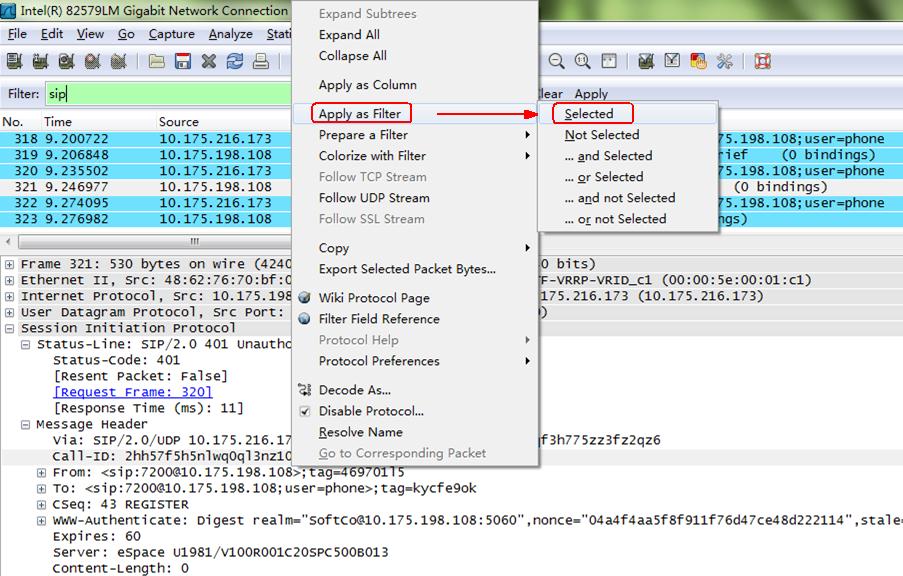
6.Choose Statistics > Flow Graph. In the dialog box that is displayed, click OK.
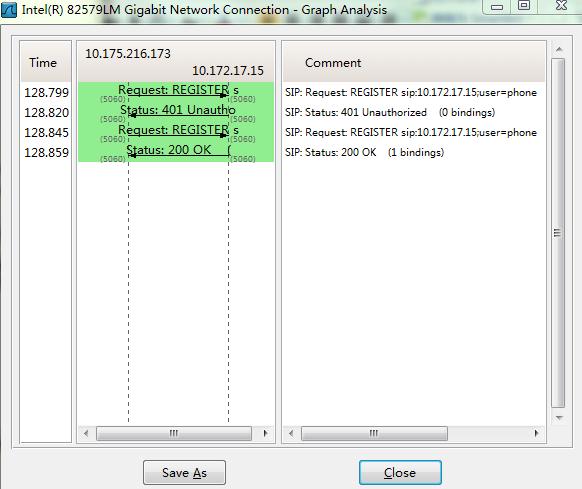
Error Code Reference
The following table describes the error codes that the X1900 unified gateway may return in response to the IP phone registration faults.
Error Code |
Meaning |
Description |
Solution |
401 |
Unauthorized |
The X1900 unified gateway asks the IP phone to send a registration request that carries the authentication information. |
No action is required. The IP phone will send such a registration request automatically. |
403 |
Forbidden |
The server supports but refuses the request. The possible causes are as follows: 1.Authentication by IP address or password fails. 2.The server does not allow registration of third-party IP phones. 3.The server does not allow preempted number registration. |
1.Verify that the IP address or password of the IP phone is correctly configured. 2.Set the value of software parameter 286 to 0. 3.Check whether the number has been registered. |
404 |
Not Found |
The user number does not exist in the domain specified by Request-URI. |
Verify the user number configuration. |
407 |
Proxy Authentication Required |
The X1900 unified gateway asks the proxy to send a registration request that carries the authentication information. |
No action is required. The proxy will send such a registration request automatically. |
408 |
Request Time-out |
The request times out. For example, an IP phone registers with the X1900 unified gateway through the SBC, but the registration interval of the IP phone is longer than the keep-alive period of the corresponding port on the SBC. When the IP phone registration is refreshed, the port is unavailable, causing the IP phone registration failure. |
Shorten the registration interval of the IP phone. |
Parent Topic: IP Phone